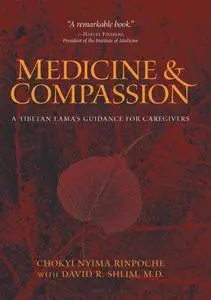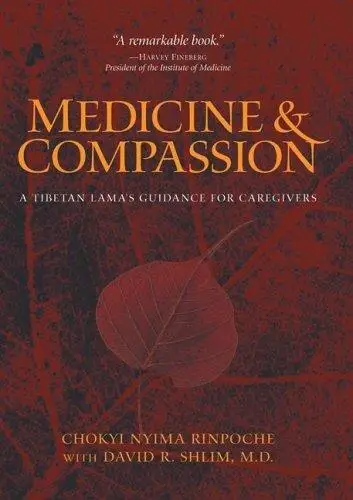Medicine & Compassion: A Tibetan Lama's Guidance for Caregivers By Chokyi Nyima Rinpoche; David R. Shlim, M.D.; Erik Pema Kunsang; Harvey Fineberg; Donald Fineberg
2006 | 194 Pages | ISBN: 0861714784 | EPUB | 1 MB
2006 | 194 Pages | ISBN: 0861714784 | EPUB | 1 MB
Description Sure to be welcomed by caregivers of all types, the groundbreaking new Medicine and Compassion can help anyone reconnect with the true spirit of their caregiving task. It is estimated that some 54 million people in the U.S. act as informal caregivers for ill or disabled loved ones. We can add to these countless workers in the fields of health and human service, and yet there is still not enough help to go around: as many as three fourths of our informal caregivers report "going it alone." It's no wonder that "caregiver burnout" and depression afflict so many. Sure to be welcomed by caregivers of all types, the groundbreaking new Medicine and Compassion can help anyone reconnect with the true spirit of their caregiving task. In a clear and very modern voice, Chokyi Nyima Rinpoche and Dr. David R. Shlim use the teachings of Tibetan Buddhist philosophy to present practical tools for revitalizing the caring spirit. Readers, in turn, will find their patience, kindness, and effectiveness re-energized. Offering practical advice on dealing with people who are angry at their medical conditions or their care providers, people who are dying, or the families of those who are critically ill, Medicine and Compassion will strike resonant chords with medical professionals, hospice workers, teachers, and parents of children with special needs, and those caring for aging and infirm loved ones. From The New England Journal of Medicine Especially since the 14th Dalai Lama received the Nobel Peace Prize in 1989, the Tibetan tradition has gained center stage in the West. This book is a simple and well-written introduction to the Tibetan variant of Buddhism, a global religion that has garnered increasing interest in the United States since Zen textbooks became available in the 1950s. In folksy English, the book explains the basics of the belief system, including the concepts of impermanence, attachment, suffering, and "emptiness suffused with compassion." Emphasizing that the Buddhist idea of "empty mind" and compassion are essentially innate and indistinguishable, the book offers simple meditation practices and visualizations (mostly having to do with concentrating on breathing) as a direct way to cultivate "nonconceptual compassion." Even though the book does not specifically target health care providers (meditation and compassion seem to be good for everyone), there are plenty of insights that will be worthwhile for caregivers. We are told that even if we are saddened because we cannot cure everyone, we can find some joy if we make our effort to help 100 percent. We are told that treatment includes gestures and nonverbal communication of reassurance, caring, calmness, and help in removing fear. We are asked to remember that we are all "waiting in line to die." Medicine and Compassion is most interesting when it touches on Tibet's unique cultural traditions. For example, it provides a dramatic glimpse into another conceptual world in its descriptions of the process of dying, during which, according to Tibetan beliefs, the spirit moves through various bardo realms, where mind-consciousness is reincarnated. Originally developed as a radical rejection of Hinduism 2500 years ago, Buddhism has always had an intense and rigorous dialogue with other religions on such issues as non-self, non-theism, and immanence. Unfortunately, this dialogue has not often taken place in the West, where Buddhism often finds itself in the environs of New Age spiritual consumerism. Although the book's introduction claims that "this is not New Age stuff," the book merges into New Age unrestrained "dispensations" as it emphasizes Buddhism as a religion of unlimited abundance that accesses the unrestricted Buddha within. This Westernized Buddhism has little to do with demand, limitation, obligation, and responsibility. Reaching enlightenment -- the arduous effort of making no effort -- is watered down to being unafraid to take a "vacation" from our hectic lives with 15 minutes of daily meditation while working toward "relaxation" (a word rarely found in any Buddhist canon). Buddhism becomes indistinguishable from what, in 1902, William James called the emerging American "Gospel of Relaxation." The weakness of this book is most evident in its discussion of Tibetan medicine itself. In fact, recognizable Tibetan medicine is not 2500 years old, as the book claims. Rather, Tibetan medicine is an amalgam of Ayurvedic, Chinese, and Hippocratic thought, synthesized with indigenous shamanism in a series of conferences inaugurated during the consolidation of the Tibetan Empire between 634 and 755 A.D. This broad-minded acceptance of diverse traditions is a rare historical example of active medical pluralism. Scholars accept that translations of some Hippocratic texts are embedded in canonical Tibetan medical books. In reading Medicine and Compassion, one easily recognizes ideas from Hippocrates's On Decorum, which states that the physician should "bear in mind his manner of sitting, [maintain] . . . decisive utterance, brevity of speech, composure, diligence, care, replies to objections, calm self-control, concentration, readiness to do what has to be done. . . . Perform all this calmly." In a curious way, the journey to the East in this book brings the reader back to Western medicine's point of departure. Medicine and Compassion is a delightful book, but for accounts that are more intellectually challenging, I would recommend Edward Conze's classic Buddhism (1951); for Tibetan Buddhism, Chogyam Trungpa's Cutting through Spiritual Materialism (1974); and for Buddhist health care perspectives, Lawrence Sullivan's Healing and Restoring (1989). Ted J. Kaptchuk Copyright © 2005 Massachusetts Medical Society. All rights reserved. The New England Journal of Medicine is a registered trademark of the MMS. About the Author David R. Shlim MD ran the world's busiest destination travel medicine clinic in Kathmandu, Nepal, for fifteen years, and was the attending physician for all the survivors of the 1996 Mount Everest disaster chronicled in Jon Krakauer's Into Thin Air. He currently lives in Jackson Hole, Wyoming. Review "A simple and well-written introduction to the Tibetan variant of Buddhism. In folksy English, the book explains the basics of the belief system, including the concepts of impermanence, attachment, suffering, and emptiness. ...There are plenty of insights that will be worthwhile for caregivers. Medicine and Compassion is most interesting when it touches on Tibet's unique cultural traditions. For example, it provides a dramatic glimpse into another conceptual world in its descriptions of the process of dying, during which, according to Tibetan beliefs, the spirit moves through various bardo realms, where mind-consciousness is reincarnated. [...] A delightful book." Author: Ted Kaptchuk, in the New England Journal of Medicine "I was dumbfounded by how much Chokyi Nyima Rinpoche comprehends the emotional challenges facing doctors in relationship to their patients. He nails it time and time again. Magnificent! I shall continue to reread it just for the pleasure of the teachings, for the clarity of his mind, and the purity of his heart. This is a very worthy project." Author: Jon Kabat-Zinn, M.D., author of Full Catastrophe Living and Wherever You Go, There You Are "Medicine and Compassion is a wonderful guide for caregivers to develop compassion and skill in helping others from their deepest heart. A very practical, easy to read, and much needed book." Author: Judith Orloff, M.D., author of Positive Energy "Among recent Buddhist publications, Medicine and Compassion is unique in being directed at medical professionals. In it, Chokyi Nyima pairs homespun advice for providing the best possible care for patients with expositions on Buddhist understandings on suffering and embodiment. In the introduction, David Shlim, MD, discusses a common problem among doctors and health care workers, namely that they often erect an emotional barrier between themselves and their patients. Chokyi Nyima offers an alternative approach, one that applies the Buddhist training in compassion to establish bonds of trust in the doctor-patient relationship. Interesting adaptations of Buddhist principles are offered [on such subjects as] the art of healing and how to assist patients through the dying process. The book concludes with chapters that introduce the Tibetan Buddhist understanding of the death process and a brief overview of Tibetan medicine." Source: Buddhadharma "It would be a mistake to think that only an adherent of Buddhism could gain from reading, reflecting, and acting on this book's ideas. Medicine and Compassion provides practical guidance to anyone who seeks to become more compassionate." Source: from the foreword "This book will be of value to any health worker who has a sincere wish to help his or her patients and who wants to nuture that wish without burning out. It will also be of value to any health worker who once had this wish and would like to recover a deep sense of caring and compassion. There is also much of value here for those who care for the terminally ill. [The book should also be read by] anyone involved in the teaching of health workers, especially those who provide clinical care." Source: Journal of Travel Medicine "Like most doctors, I sometimes lack compassion. Once, as an intern, exhausted beyond caring, I discharged a favorite patient from the hospital despite his obvious downward spiral. My so-called excuse? I needed to lower my inpatient census! Today, almost 30 years later, I am still pained when I remember the baleful looks that he and his wife cast my way when he was readmitted the following morning. They knew that I had abandoned him, and so did I. That I can clearly recall such a moment is telling. Medicine and Compassion: A Tibetan Lama's Advice for Caregivers is full of wisdom for any doctor whose well of medical empathy has at some time run dry. It represents the collaboration of a Tibetan Buddhist monk from Nepal and a Western-trained doctor, David Shlim, who first crossed paths when Shlim was director of the largest Western medical clinic in the Kathmandu Valley in Nepal. Shlim now lives in Jackson Hole, Wyoming, and has recently led several courses with his longtime friend and teacher. In writing this book, the two have tapped a genuine need in contemporary American medicine. The first section of the book touches on universal truths, as well as classic Buddhist teachings. However, a central theme of this section that is beyond debating is the profound influence of emotions and mental attitude on the experience of aging, sickness, and death. The second section of the book examines our potential for and various means of achieving a greater level of compassion. In the third section, come simple but profound thoughts on how to render the best possible care to all patients-including the aged, irritable, aggressive, or uncooperative- as well as how to nurture lifelong attitudes that ease the process of dying. The book ends with an overview of the 2500-year-old tradition of Tibetan medicine, in some ways a surprisingly modern "science" in its broad application to physical illness, bad energy or evil influence, and emotional disorders. Medicine and Compassion is easy to recommend, because it squarely confronts one of medicine's perennial challenges- namely, how to grow in wisdom and kindness, as well as in knowledge, and how to care for patients with all of the above. In my view, these matters are not given sufficient attention in many modern clinical purviews. In this data-driven, technologic era of doctoring, the spiritual focus is easily lost. Medicine and Compassion is a good reminder of the lessons that ancient teachings and contemporary religion can offer to our collective 21st century profession and to our individual humanity as healers." Source: Clinical Infectious Diseases



